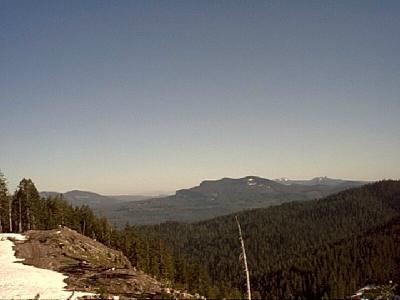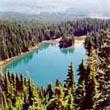|
Oregon and Washington Trips:
With the summer months approaching, now is the time to mark the
calender and prepare your gear for some multi-day trips and expeditions
in the northwest. Over the next few months the BFRO's Jeff Lemley
will be arranging several group trips into the Gifford
Pinchot National Forest, Snoqualmie Nationl Forest and Mt. Hood
National Forest.
The groups will focus on the "Dark Divide" region, and
Indian Heaven Wilderness, both located in between Mt. St. Helens,
and Mt. Adams. These areas have a long history of sasquatch sightings
and related evidence.
If you are interested in participating please e-mail Jeff at Jeff_L@BFRO.net
In the e-mail please indicate any special gear you can bring to
the table (see the list below) or any experience you have in investigating
bigfoot sighting areas.
More
details about the first trip -- Gifford Pinchot National Forest,
May 19-21.

A view from
within the "Dark Divide", looking south toward Indian
Heaven Wilderness. These areas are near the Oregon/Washington border.
Northern California Trips:
For information about BFRO field investigations and group trips
in Northern California and Southern Oregon, contact John Frietas
at JohnF@BFRO.net
Special Gear to Bring:
The BFROs field investigation trips are not suited for beginning
campers and hikers. We require participants to have some outdoor
experience, saftey knowledge and survival skills, in addition to
all your own equipment and supplies -- basic camping and/or backpacking
gear one would normally need for a trip to these kinds of areas
in the given season.
Here's a partial list of special gear which would be useful. When
inquiring about going on a BFRO trip be sure to let us know about
any special gear you own and can bring with you.
Camcorder
The current camcorder of choice is any model
of the Sony Night Shot series, either digital ($1000) or Hi8 ($400).
A distinguishing feature of these camcorders is the "night
shot" capability. It is not a "starlight scope" like
military snipers use, nor is it a heat sensing infrared system like
police helicopters use. Rather it is a "passive infrared"
system that requires small amounts of near-visible infrared to see
in the dark. Small amounts of near-visible infrared are usually
present when any amount of artificial or natural light is present.
The unit has a built in infrared emitter which illuminates objects
up to 30 feet away.
To extend the range of the built-in infrared emitter, you can buy,
as an accessory from Sony, an infrared booster.
Audio
Recorder
A standard tape recorder from Radio Shack,
or elsewhere, will sufficce. Two important features for your recorder
to have: 1) a jack for an external mic, and 2) a tape counter: The
tape counter will come in handy when taking notes while doing continuous
recordings. The mic jack will allow you to use a variety of different
microphones.
The best mic to use is any omni-directional mic that is well suited
for recording faint or distant noises. Most mics are designed for
singers or speakers, and thus try to impede background noise. So
don't settle for any old mic because it may be completely useless
in the field. A good microphonen may easily cost more than the recorder
itself .
Spotlight
A high power spotlight is useful in a number
of situations. Many veteran field investigators will tell you that
a powerful spotlight seems to be the best protection from a aggressive
bigfoot -- even better than a gun.
A 1-million-candlepower halogen spotlight can be purchased at Wal-Mart
for under $20.
Most big halogen spotlights come with an accessory for plugging
it into a cigarette lighter. Some models also have small clamps
for direct connections to 12 volt batteries. This is useful if the
campsite is some distance from a vehicle.
35mm
Camera
Even if you have a digital video camera,
a 35mm still photo camera is still a great thing to carry.
Your expedition leader should be informed at the first meeting
if you do have better than average 35mm photography skills.
Using a 35mm camera for things that are not moving and do not make
sounds (such as footprints and landscape views), allows you to get
exceptionally detailed documentation of those things, while conserving
precious battery power for the camcorders.
Casting
Material
Do not use plaster of Paris to cast footprints.
Plaster crumbles too easily. You want to use some kind of molding
cement. Here are a few to types of cement products recommended for
casting animal tracks:
- Ultracal 30: One of the best materials for making casts
of tracks. It's manufactured by U.S.Gypsum. Find it in building
supply stores that sell plaster supplies to building contractors.
Ultracal 30 sets in 30 minutes.It has almost no expansion or contraction
when it sets. The cost is about $20.00 for a 100 lb bag.
- Dental Stone is stronger, and shows greater detail than
Ultracal 30. It is also more expensive at $30.00 for 25 lb bag.
Dental stone can be ordered online from John Frietas (www.bluenorth.com)
or found at any dental supply outlet.
- Quik Roc is also very good for casting tracks. It's solid
and durable, and relatively cheap at $25.00 for 50 lbs. Best feature:
It dries in less than 10 minutes. Call around to local building
supply stores to see which places carry Quik Roc. Not all hardware
stores will have it.
- Hydrocal Gypsum Cement is identical to Ultracal 30, except
that it takes longer to dry.
GPS
Unit
GPS units are useful in a number of situations. They are good
for safety and unmatched at providing accurate data that will allow
you or others to return to a precise location.
The BFRO encourages eyewitnesses to gather GPS data at the scene
of their encounter. The two most important readings are the spot
where the bigfoot was standing, and the spot where the eyewintesses
were standing. That info is very useful when field investigators
are trying to reconstruct the incident.
A Magellan Blazer (or comparable unit) can be purchased for as
little as $100 at many stores. These low end units suffice for most
purposes.
CB
Radio
CB radios (transceivers) are the best option
for reliable outdoor communications at minimal cost. CBs will be
the standard communication device for BFRO group trips. To participate
in large group trips, you must have either a car-mounted or handheld
CB. At Radio Shack they range from about $40 for a no frills car-mounted
unit, up to the most powerful, 5-watt cell-phone-sized, digital,
40-channel CB walkie talkie, for around $130.
Local
Maps
When exploring a National Forest that you
are unfamiliar with, the best safety and productivity insurance
you can buy is a Forest Service map. Forest Service maps (FS maps)
often show more up-to-date and relevant details than USGS topo maps.
FS maps cost around $5 and are mandatory for anyone wanting to
go on any BFRO expeditions in any National Forests.
Safety
/ First Aid
All persons participating in BFRO trips
and expeditions will be responsible for their own safety and supplies.
Bring a decent first aid kit for yourself and your own group.
Firearms
Some people do not feel comfortable in
the woods without a gun among their gear. That's OK with us, but
we insist you limit your weaponry to one handgun per person, carried
in accordance with local firearms laws.
If the thought of actually encountering a bigfoot in the wild scares
you so much that you wouldn't feel comfortable without an assault
rifle, then you simply should not attend any of these trips.
Pac NW Newsletter Front Page
BFRO Homepage
|


